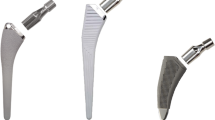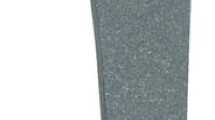Abstract
Introduction
The current strategy for modular neck failures in total hip arthroplasty (THA) is calibrated on CrCo neck failures. Stem revision is usually required, but the procedure is challenging and achieves modest outcomes (up to 20% of re-revisions at short-term). No study reports revision strategies and outcomes after Ti neck failures. Aims of the study were to evaluate: (1) demographic and implant features of the cohort to be revised, (2) intra-operative findings and surgical revision strategies and (3) clinical and radiological post-revision outcomes.
Materials and methods
Hospital database was enquired about revisions due to Ti neck failures in primary THAs. Sixty-five revisions were enrolled (all with the same modular system). Neck exchange was attempted as the first-line treatment. Patients were clinically and radiographically evaluated after revision.
Results
The revision cohort encompassed fatigue neck fractures occurred 4.4 ± 2.6 years after THA: patients < 65 years and/or > 80 kg (98.5%) were predominant. Fifty-three neck exchanges were performed (81.5%). Eleven failures required stem revisions (16.9%), generally due to demanding neck extraction. Six complications occurred after neck exchange (11.3%), among them 2 acute infections requiring surgery (3.8%). Among stem revisions, one aseptic loosening and one neck re-fracture (18.5%) required re-revisions. At a mean follow-up of 7.1 ± 4 years, the neck exchange cohort achieved a mean HHS of 89.1 ± 6.3 (stem revisions: 84.1 ± 10.9).
Conclusions
Revisions for Ti neck failures were predominantly performed due to fatigue fractures. In case of failures, neck exchange is a feasible procedure in most of the cases, with good outcomes at 7 years.
Level of evidence
Level IV, retrospective case series.





Similar content being viewed by others
Data availability
The data that support the findings of this study are available from the corresponding author, upon reasonable request.
References
Massin P, Geais L, Astoin E, Simondi M, Lavaste F (2000) The anatomic basis for the concept of lateralized femoral stems: a frontal plane radiographic study of the proximal femur. J Arthroplasty 15(1):93–101
Traina F, De Clerico M, Biondi F, Pilla F, Tassinari E, Toni A (2009) Sex differences in hip morphology: is stem modularity effective for total hip replacement? J Bone Jt Surg Am 91(Suppl 6):121–128
Srinivasan A, Jung E, Levine BR (2012) Modularity of the femoral component in total hip arthroplasty. J Am Acad Orthop Surg 20(4):214–222
Graves SE, de Steiger R, Davidson D, Donnelly W, Rainbird S, Lorimer MF, Cashman KS, Vial RJ (2017) The use of femoral stems with exchangeable necks in primary total hip arthroplasty increases the rate of revision. Bone Jt J. 99B(6):766–773
Walsh CP, Hubbard JC, Nessler JP, Markel DC (2015) Revision of recalled modular neck rejuvenate and ABG femoral implants. J Arthroplasty 30(5):822–826
Barlow BT, Boles JW, Lee YY, Ortiz PA, Westrich GH (2016) Short-term outcomes and complications after rejuvenate modular total hip arthroplasty revision. J Arthroplasty 31(4):857–862
Dimitriou D, Liow MH, Tsai TY, Leone WA, Li G, Kwon YM (2016) Early outcomes of revision surgery for taper corrosion of dual taper total hip arthroplasty in 187 patients. J Arthroplasty 31(7):1549–1554. https://doi.org/10.1016/j.arth.2016.01.015
Talmo CT, Robbins CE, Siddiqi A, Nandi S, Bono JV, Ward DM (2020) Revision of a dual-modular stem in patients with adverse tissue reaction. Hip Int 30(4):452–456. https://doi.org/10.1177/1120700019869616
Inoue D, Restrepo C, Nourie B, Hozack WJ (2020) Clinical results of revision hip arthroplasty for neck-taper corrosion and adverse local tissue reactions around a modular neck stem. J Arthroplasty 35(6S):S289–S293. https://doi.org/10.1016/j.arth.2020.02.057
Kwon YM, Fehring TK, Lombardi AV, Barnes CL, Cabanela ME, Jacobs JJ (2014) Risk stratification algorithm for management of patients with dual modular taper total hip arthroplasty: consensus statement of the American Association of Hip and Knee Surgeons, the American Academy of Orthopaedic Surgeons and the Hip Society. J Arthroplasty 29(11):2060–2064
Fokter SK, Moličnik A, Kavalar R, Pelicon P, Rudolf R, Gubeljak N (2017) Why do some titanium-alloy total hip arthroplasty modular necks fail? J Mech Behav Biomed Mater 69:107–114. https://doi.org/10.1016/j.jmbbm.2016.12.012
Kop AM, Keogh C, Swarts E (2012) Proximal component modularity in THA–at what cost? An implant retrieval study. Clin Orthop Relat Res 470(7):1885–1894
Grupp TM, Weik T, Bloemer W, Knaebel HP (2010) Modular titanium alloy neck adapter failures in hip replacement–failure mode analysis and influence of implant material. BMC Musculoskelet Disord 11:3. https://doi.org/10.1186/1471-2474-11-3
Ollivier M, Parratte S, Galland A, Lunebourg A, Argenson JN (2015) Are titanium-on-titanium TiAl6V4 modular necks safe in total hip arthroplasty for non-overweight patients? results of a prospective series at a minimum follow-up of 7 years. Eur J Orthop Surg Traumatol 25(7):1147–1152
Traina F, Bordini B, De Fine M, Toni A (2011) Patient weight more than body mass index influences total hip arthroplasty long term survival. Hip Int 21(6):694–699
Scott CEH, Turnbull GS, Powell-Bowns MFR, MacDonald DJ, Breusch SJ (2018) Activity levels and return to work after revision total hip and knee arthroplasty in patients under 65 years of age. Bone Jt J. 100B(8):1043–1053
Montalti M, Castagnini F, Giardina F, Tassinari E, Biondi F, Toni A (2018) Cementless total hip arthroplasty in Crowe III and IV dysplasia: high hip center and modular necks. J Arthroplasty 33(6):1813–1819
Moore MS, McAuley JP, Young AM, Engh CA Sr (2006) Radiographic signs of osseointegration in porous-coated acetabular components. Clin Orthop Relat Res 444:176–183
Muir SW, Al-Ahaideb A, Huckell J, Johnson MA, Johnston DB, Beaupre LA (2011) Radiographic assessment of uncemented total hip arthroplasty: reliability of the Engh Grading Scale. Can J Surg 54(3):185–188
Brooker AF, Bowerman JW, Robinson RA, Riley LH Jr (1973) Ectopic ossification following total hip replacement. Incidence and a method of classification. J Bone Jt Surg Am. 55(8):1629–1632
Maniscalco P, Quattrini F, Ciatti C, Ghidoni L, Ghidoni G, Burgio V, Pogliacomi F, Vaienti E, Ceccarelli F (2020) Neck modularity in total hip arthroplasty: a retrospective study of nine hundred twenty-eight titanium neck implants with a maximum follow-up of eighteen years. Int Orthop 44(11):2261–2266
Lex JR, Welch MD, See A, Edwards TC, Stavropoulos NA, Babis GC (2021) Systematic review of primary total hip arthroplasty using titanium-titanium modular-neck prostheses: the true risk of revision. Hip Int 31(3):295–303. https://doi.org/10.1177/1120700020916870
Modula system, Adler Ortho, Milan. http://www.adlerortho.com/wp-content/uploads/2019/07/modula.pdf. Last access: 27 Mar 2021
Funding
The authors did not receive support from any organization for the submitted work.
Author information
Authors and Affiliations
Contributions
FC and FT concepted the design of the study. BB, SL and MC provided the data, analyzed the data and conducted the statistical analysis. FC, SL and ET wrote the manuscript. ET and FT supervised the article production and corrected the final paper. All the Authors read and approved the final version.
Corresponding author
Ethics declarations
Conflict of interest
The authors have no relevant financial or non-financial interests to disclose.
Ethical review committee statement
Institutional board review approved the study (IRB 211/2022/Oss/IOR, 25/3/2022).
Informed consent
No informed consent was waived due to the nature of the study.
Additional information
Publisher's Note
Springer Nature remains neutral with regard to jurisdictional claims in published maps and institutional affiliations.
Rights and permissions
Springer Nature or its licensor (e.g. a society or other partner) holds exclusive rights to this article under a publishing agreement with the author(s) or other rightsholder(s); author self-archiving of the accepted manuscript version of this article is solely governed by the terms of such publishing agreement and applicable law.
About this article
Cite this article
Castagnini, F., Bordini, B., Lucchini, S. et al. Mid-term outcomes of revision hip arthroplasty due to titanium modular neck failure. Arch Orthop Trauma Surg 143, 5909–5918 (2023). https://doi.org/10.1007/s00402-023-04805-1
Received:
Accepted:
Published:
Issue Date:
DOI: https://doi.org/10.1007/s00402-023-04805-1




